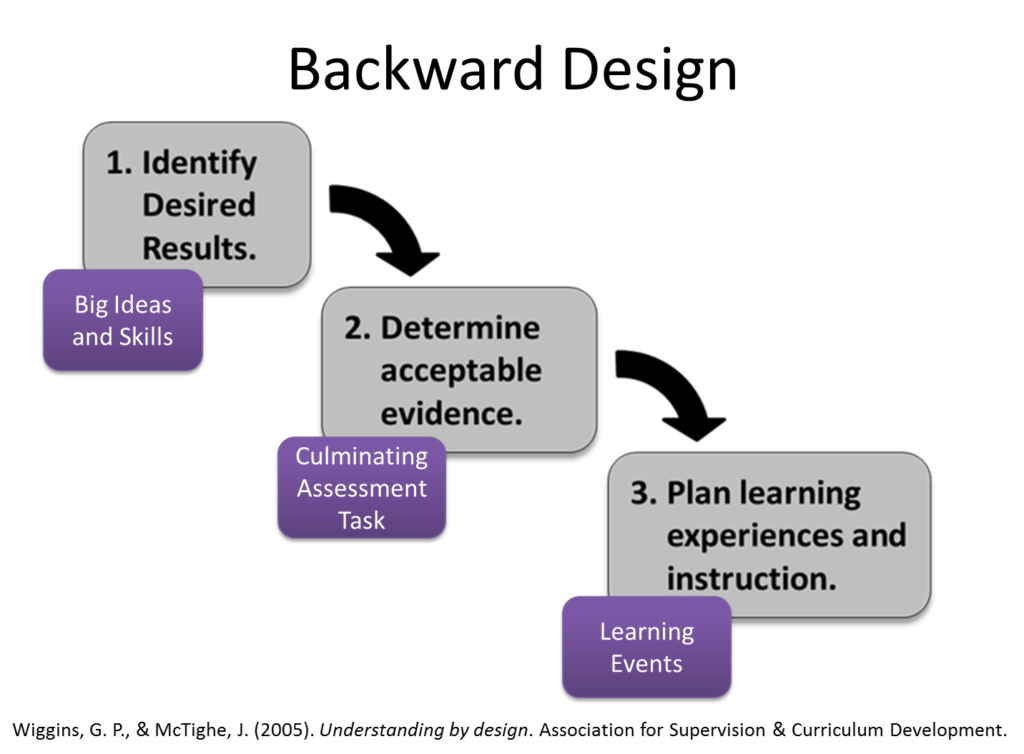Fiction/Storytelling Unit:
Designing Significant Learning Experiences for Newcomer Emergent Bilingual Students - UbD
The Fiction and Storytelling unit is designed to help newcomer emergent bilingual students develop their reading and writing skills in fiction, and to appreciate the diversity and complexity of human experiences, perspectives, and cultures, as represented in fiction stories. This version of the unit’s learning plan follows the Understanding by Design (UbD) framework, which consists of three stages: Stage 1 – Identify Desired Results, Stage 2 – Determine Acceptable Evidence, and Stage 3 – Plan Learning Experiences and Instruction. The unit also uses the WHERETO and GRASPS elements to guide the implementation of the learning plan.
Understanding by Design (UbD) Framework - English Learners Language Arts Curriculum: Fiction and Storytelling Unit
Finks 3 Column Table vs. Understanding by Design: A Comparative Analysis
Effectively teaching and facilitating learning means making sure that students not only learn, but also have meaningful experiences that are applicable to the real world. This requires carefully planning how and what to teach. Two ways that can help with this are L. Dee Finks’ 3 Column Table and Understanding by Design (UbD). Each way has its own ideas and steps for making teaching more effective and meaningful.
Finks’ 3 Column Table: A Focus on Learning Outcomes
Finks’ 3 Column Table is a goal-oriented approach to learning design that emphasizes the alignment of learning objectives, teaching activities, and assessment strategies. The framework utilizes a three-column structure to categorize the desired learning outcomes, the corresponding teaching and learning activities, and the methods for evaluating student progress.
Understanding by Design: A Backward Design Approach
UbD, on the other hand, advocates for a backward design approach, emphasizing the starting point of determining the desired learning outcomes and then designing teaching and learning activities that will effectively lead students to achieve those outcomes. The UbD framework encompasses three stages: Stage 1 focuses on identifying desired understandings, Stage 2 outlines assessment methods, and Stage 3 designs learning activities.

Comparative Analysis: Strengths and Applications
I believe both Finks’ 3 Column Table and UbD offer key strengths and are appropriate for different educational contexts. Finks’ 3 Column Table provides a clear and structured approach to aligning learning objectives, teaching activities, and assessment strategies. This makes it an ideal tool for educators who are seeking a straightforward approach to planning their lessons.
UbD, with its emphasis on backward design, is great for designing comprehensive curriculum units that focus on developing deep understanding and transferable skills. The framework’s emphasis on desired understandings ensures that learning activities are aligned with the intended outcomes, leading to a more cohesive and impactful learning experience.
Contribution to My Innovation Plan: Technology-Enhanced Project-Based Learning for Newcomer Emergent Bilingual Students
Both Finks’ 3 Column Table and UbD have significantly contributed to my ability to design effective learning environments and curriculum. Finks’ 3 Column Table’s emphasis on alignment has been instrumental in ensuring that my lesson plans and activities are clearly linked to the desired learning outcomes for newcomer emergent bilingual students, who are my innovation plan’s target student group. This alignment has helped me create a more cohesive learning experience that supports their language development and academic progress.
UbD’s backward design approach has guided me in crafting a curriculum that is centered on deep understanding and transferable skills. By starting with the desired results, I have been able to design a coherent and comprehensive curriculum unit that addresses the content-specific and language acquisition goals of the unit, and that incorporates the elements of fiction and storytelling as the main theme and focus of the unit.
In conclusion, both Finks’ 3 Column Table and Understanding by Design offer valuable frameworks for designing effective learning environments and curricula. Finks’ 3 Column Table’s focus on alignment and UbD’s backward design approach provide educators with tools to create meaningful learning experiences that foster student growth and achievement. As I continue to develop my innovation plan for a TPBL curriculum for newcomer emergent bilingual students, these frameworks will continue to guide my design process, ensuring that the curriculum is aligned with the specific needs and goals of this unique student population.
References
L. Dee Fink. (2003). A self-directed guide to designing courses for significant learning. Jossey-Bass.
Wiggins, G., & McTighe, J. (2005). Understanding by design (2nd ed.). Association for Supervision and Curriculum Development.